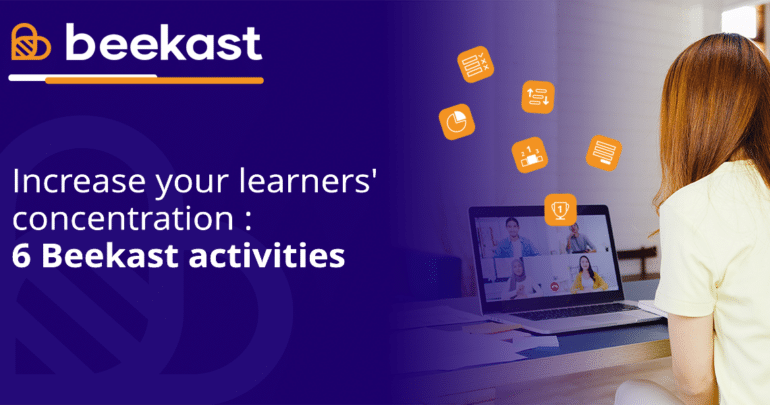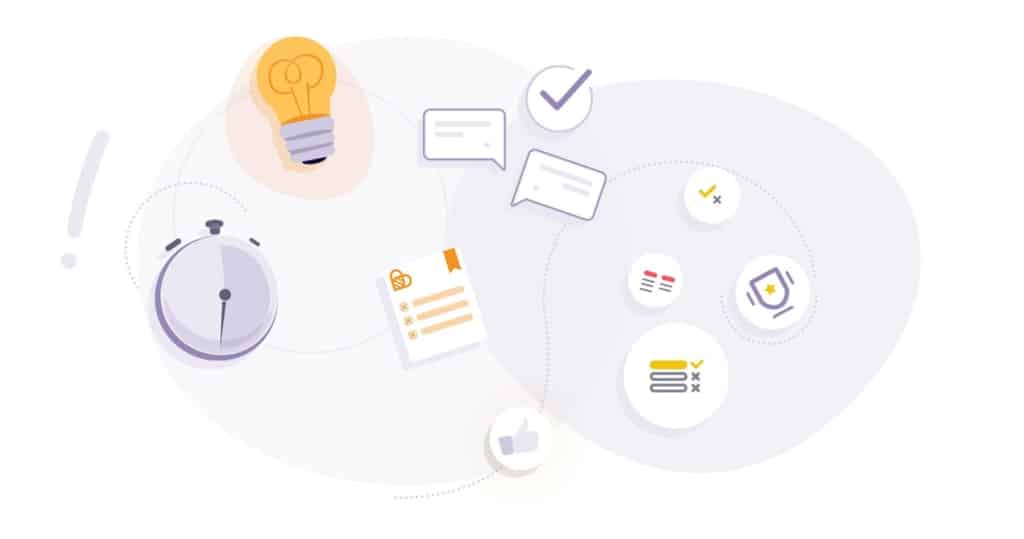Concentration is a key element of learning. In order to acquire new skills and knowledge, learners must be able to fully concentrate on the training content.
On the other hand, without adequate concentration, learners may miss important information and not get the most out of the training. This concentration also helps them stay engaged and motivated throughout the training.
Several factors can prevent employees from concentrating at work, such as working in an open space, lack of sleep, or distraction caused by social media use.
The use of interactive activities can play a crucial role in maintaining the attention and interest of employees during a meeting or training. So how can these activities help you achieve this goal?”
Increase your learners’ concentration: 6 Beekast activities
Before starting your training, consider organizing breathing exercises that will help your employees work on their concentration. Also, occasionally consider organizing meditation or yoga activities for 15 to 20 minutes that will help your employees develop their long-term concentration abilities.
Therefore, Beekast offers you stimulating and dynamic breathing exercise templates that allow you to optimize their concentration time and reduce any elements that may distract them:
- Create Your Character: This is an activity where you invite your participants to build a character that resembles them and reflects their state of mind before your session.
You can use it as an icebreaker to engage your participants right from the start of the training, which helps improve their concentration and energize the group.
- World Cloud: This activity is ideal not only for brainstorming but also for collecting learners’ expectations for the training.
During this activity, you ask a simple question to generate immediate excitement and then bounce off each participant’s expectations. Then, the learners send in words that are projected live on a screen as a word cloud, in real-time or not, depending on your choice.
This activity is suitable for the beginning of a session to focus participants’ attention and motivate them to contribute. It requires mental concentration on their part.
- MCQ: Asking multiple choice questions during a training session not only helps determine if all participants are on the same page but also develops their cognitive abilities.
Use Beekast’s “MCQ” activity, which is ideal for engaging the group and keeping their attention. Participants vote by choosing one or more answers, and then the results are displayed either as a percentage in the form of a histogram or as a podium highlighting the top performers.
- Starfish: It is always important to review the progress of a training session to ensure that everything was clear and that participants did not encounter any difficulties.
The “Starfish” inspiration template is ideal for conducting this review, as each participant expresses their thoughts on what went well or less well during the training, what should be stopped or started, and what to do more or less of.
Each participant takes their time to explain each idea (turn-by-turn mode), and if you notice similar ideas, you can group them together.
- Speed car: After reviewing the past and evaluating the training, it is time to look forward and determine the training and actions needed for the future. To do this, the “Speed Car” inspiration model allows you to reflect on the future with a look at the past.
This activity takes place in two phases. In the first phase, participants look back in their rearview mirror and reflect on the “engines” and “parachutes” (trainings completed) that have brought them to where they are now.
During the second phase, they will project themselves into the future and express their future training needs. You can set a time limit for each phase and end them either when the time is up or when participants stop sending ideas.
At the end of these two phases, you can also plan a voting session on the necessary training, which will allow you to establish an action plan for the future.
- Plus & Delta: to wrap up the training, gather feedback from your participants to ensure they have assimilated the knowledge and were engaged throughout the training.
Use the “Plus & Delta” inspiration model, which allows learners to share their positive and negative feedback. They can share the benefits of the training (plus) and what needs to be improved for the future (delta).
In summary, concentration is essential for successful learning, and by using interactive strategies, you encourage learners to participate and maintain their engagement throughout the training.
Using the aforementioned models will be very useful to develop your learners’ concentration and maintain their attention. This way, you improve the effectiveness of the training and maximize the learners’ learning.

